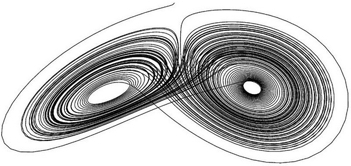Some SOURCES (books, etc.)
for ODE and other Math/Physics coding projects:
-
BOOK:
'FORTRAN for Physics'
by
Alfed M. Bork, 1967 (QC20.2.B734),
includes examples such as:
-
Planetary motion,
pages 15 and 33-plus
-
3-body problem,
pages 45 to 62 (code on page 56)
-
Harmonic oscillator,
pages 11 and 27-plus
-
BOOK:
'Theoretical Physics on the Personal Computer'
by Schmid, Spitz, and Losch, 1990 (QC20.7),
includes FORTRAN code with a 'RUNGE' subroutine
-
BOOK:
'Applied Differential Equations'
by Murray Spiegel, 1st ed. 1958,
3rd ed. 1981 (QA371.S82),
lots of examples
-
BOOK:
'Modelling with Differential Equations'
by Burghes and Borrie, 1981 (QA372.B955),
nice examples
-
BOOK:
'Periodic Motions'
by Miklos Farkas, 1994 (QA371.F),
includes examples such as:
-
Lotka-Volterra predator-prey model,
pages 114 to 121
-
Predator-prey model with memory,
pages 439 to 456
-
Linear systems
(constant coefficient; periodic coefficient; forced)
-
Hill's and Mathieu's equations
-
Lienard's equation
(autonomous ; periodically forced)
-
Duffing's equation
(autonomous ; periodically forced)
-
Van der Pol's equation
-
BOOK:
'Short History of Mathematical Population Dynamics' by Nicolas Bacaer
(HB849.51.B33)
-
BOOK:
'Physics and Computers'
by Robert Ehrlich, 1973 (QC20.2.E33),
includes examples such as:
- Solution of Schrodinger equation
- Analysis of bubble chamber photos
(calculation of mass)
- Discharge of capacitor in an RC circuit
- RLC series circuit (free and forced)
- Waves in 2 dimensions
(moving source and shock waves)
- Superposition of waves
(Fourier synthesis)
- Equipotential plot for 2 point charges
- Potential for a charged thin wire
- Simulation of a chain reaction
- Least squares line fit of data
- Monte Carlo calculation of center of mass
-
BOOK:
'Solved Problems in Classical Mechanics'
by DeLange and Pierrus (QA809.D43)
-
BOOK:
'The Mechanics Problem Solver'
by Fogiel, 1980 (QA809)
Some REFERENCES that
may give some insight on ODE's
-
BOOK:
'Excursions in Calculus'
(Interplay of the Continuous and Discrete)
by Robert Young, 1992 (QA303.Y66)
-
BOOK:
'Excursions in Classical Analysis'
by H. Chen, 2010 (QA301.C49)
-
BOOK:
'Analytical Mechanics'
by Fowles, 1986
-
BOOK:
'Basic Physics of the Solar System'
by Blanco and McCuskey, 1961
-
BOOK:
'Classical Mechanics: A Modern Perspective'
by Barge and Olsson, 1995
(section 8.2 is on tides)
-
BOOK:
'Classical Mechanics'
by Kibble, 1966 (QC125)
-
BOOK:
'Classical Mechanics'
by Goldstein, Poole and Safko, 3rd ed. 1950
(section 5.8 is on equinoxes)
-
BOOK:
'Classical Dynamics of Particles and Systems'
by Thornton and Marion. 5th ed., 2004
-
BOOK:
'From Eudoxus to Einstein:
A History of Mathematical Astronomy'
by Linton, 2004
-
BOOK:
'The Sheer Joy of Celestial Mechanics'
by Grossman, 1996 (QB351)
-
BOOK:
'Gravity' by
George Gamow, 1962
-
BOOK:
'Gravity and the Earth'
by
Alan Cook, 1969
-
BOOK:
'Gravity'
by Chuji Tsuboi, 1983 (QB331)
-
BOOK:
'Gravity from the Ground Up'
by
Bernard Schutz, 2003 (QC178.S36)
-
BOOK:
'Fluid Mechanics'
by
R. C. Binder, 1943 (QA901)
-
BOOK:
'Fluid Dynamics for Physicists'
by T. E. Faber, 1995 (QC151.F33)
-
BOOK:
'Numerical Simulation in Fluid Dynamics'
by Michael Griebel (QA911.G718)
-
BOOK:
'Principles of Continuum Mechanics'
by Reddy (QA808)
A related area to ODE's is 'Calculus of Variations' :
Some WebSite Sources
Some free e-books may be available from
freebookcentre.net (no registration required!! no attempts to keep you
on their web pages!! no annoying popups!!) in the areas of
Physics and
Mathematics --- in particular in the areas of
A similar 'free ebooks' site is (or was) at
e-booksdirectory.com.
See the Mathematics and Science-Physics categories.
Some 'free ebooks' and 'free HTML sites' in the
math and
physics categories are/were at physicsdatabase.com.
At openlibrary.org, you can use the Search field
at the bottom of the
math and
physics pages to find books on specific topics.
You can sort the results by 'most recent' (newest) or
'first published' (oldest).
Also, see the Mathematics and Physics 'bookshelves' on the
Science Bookshelf page of gutenberg.org --- for some
classic volumes (generally more than 80 years old).
A
list of problem and excercise books in physics may still be available
at the University of Wisconsin library.
For some links to more sources of 'freely available physics books', see
this link at physics.stackexchange.com.
|

